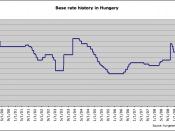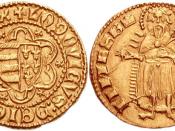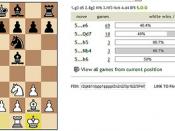In order to understand Hungary's Euro-policy it is necessary to take a deeper insight into its political history in the face of economic development and monetary integration.
The Hungarian political system is characterised by bureaucratic elements such as the power being in the hand of political elites. Reforms are still being made according to power instead of considering social and economic benefits. This is mainly due to its communist historical roots. The early abundance for divergence had long-term consequences for social expectations, party for competition but most of all for bureaucratic politics. Politicians have been creating reforms in the face of winning social acceptance through offering welfare protection rather than by creating economic stability for the Euro acceptance. (Dyson, 2008)1. Hungary before the EU accessionHungary having been under a socialist regime for forty years had developed communist roots in its political system. However, Hungary's political transformation had started relatively early compared to the other former communist countries from the Eastern Block due to a powerful freedom revolution in 1956.
The revolution brought some political and economic changes that eased the path towards the well-desired "Europeanization". Among the first reforms, the revolution brought to Hungarians was freedom of travel, more social protection, and a wide welfare and economic reform. The two latter reforms however had been too costly in the terms of macroeconomic instability. The suddenly overloaded social, political and economic agenda resulted in a loss of macroeconomic control, which brought high budget deficits, inflation and foreign debt on the long run. (Antal-Mokos, 1998)Hungary had its first democratic government in 1990, which made an attempt for a radical heal by cutting back on welfare benefits. The outcome was a sharp raise in prices that brought social conflicts. In response the government increased welfare provisions again to avoid "marketisation", which was done by introducing retirement benefits, increasing unemployment benefits and emphasising on public health care. (Vanhuysse, 2006) However, besides wanting to create a stable welfare state, "the government shared a belief in the benefits of a 'return to Europe' and tried to convince Hungarians that social confrontation is non-European, therefore it is to be avoided" (Greskovits, 2008). Nevertheless, this post-communist intention of welfare reform did not manage to solve the problem of macroeconomic instability. By 1995 government overspending pushed deficits to 10% of GDP and increased the already high public debts. Unemployment rose, and Hungary soon experienced a double-digit inflation (Eurostat).
1995 brought a change of government (a coalition of Socialists and Democrats) that launched a stabilisation programme in order to restore macroeconomic stability. The new policies brought temporary success but made a considerable cutback on welfare spending and public employment. These policies created an overall shock among the population and resulted in a loss of trust in Socialist and Democrats and reinforced the welfare-oriented structure of political life. However, the new reform helped improve exports and foreign investments, and accelerated economic growth by 5% per year. Moreover, inflation dropped from 30% in 1995 to 10% in 2000, the national currency got stabilised and current account deficit got reduced. That time Hungary experienced a huge economic improvement. By 2000 government deficit got reduced for 3% of GDP and the debt from 80% of GDP to 55%. Chart III.1 in Appendix shows the sudden large GDP increase from 1996 to 1997 and a stable rise onwards. (KSH)However, with the rapid process of Europeanization, political elections in Hungary have become similar to those in Western Europe. During campaigns rivalry and interest-group politics gained importance. Politicians promised both economic and welfare protectionism and tried to implement a mix of them at the expense of fiscal overspending. (Sachs, 1995) Entering the Eurozone required fiscal reforms and an independent Central bank, however, bureaucratic politics started to struggle with control over the Ministry of Finance. Moreover, the coordination of fiscal and monetary policies proved to be more difficult than any of the governments expected. Politicians' aim of achieving central bank independence was out of control, which hindered the coordination of fiscal and monetary policies even after the EU accession. The change of presidents of the Hungarian National Bank (MNB) became more frequent, and the gradually Europeanised central bank laws improved policymaking authority. In addition, welfare politics continued to cause difficulties because the rather nationalist politicians usually could not reach their voters without first addressing their demands for social welfare. Political opportunities also have been influenced by demands for macroeconomic stability and critical political events. (Dyson, 2008)Between 1998 and 2006 political competition focused on social welfare and Europeanization. Public disappointment with the left-led government contributed to the victory of the right-wing Conservatives. The new government combined growing output, employment and living standards with improving macroeconomic fundamentals, despite difficult external conditions. The period between 1999 and 2001 brought temporary success to the practice of Hungarian capitalism. For the first time domestic consumption and output were boosted by fiscal measures. The government raise minimum wages by 80% and development programs for infrastructure, public constructions and tourism were launched. The construction program gave a chance to the rise of small, - and medium sized businesses while the improvements in tourist sector started to bring foreign investment. (Greskovits, 2006) The stimulation of domestic growth and demand resulted in large budget deficit and current account deficit. (KSH) The Hungarian forint also started to devaluate, it became turbulent against other currencies, and exchange rates started to rise, which lead to high interest rates.
Preparing for early Euro entry (by 2006), the Hungarian National Bank (MNB) allowed the Hungarian forint to float within 30% against the Euro. A policy of inflation targeting was introduced and the exchange rate was used as a tool of disinflation. (NMB Report, 2004) Soon complying with the Maastricht Convergence Criteria became the major political issue of the right-wing coalition government, especially because an early 2004 ERM II entry was planned. These plans required strict and sudden fiscal adjustments that were not at all favourable with the population.
Due to the sudden loss of trust in the right-wing in 2002 the new elections strengthened the power of the left-wing again, which won over the right-wing coalition government by offering a still popular program, a transformation with welfare. The new government brought political uncertainty once again. While the new prime minister was trying to restore balance by carrying out the promised increase in the wages of public-sector, in pensions, and in housing loans, the Hungarian National Bank refused to accommodate the consequences of fiscal overspending, mainly because it was the Central Bank's responsibility to keep up with the meeting of criteria required for the early Euro entry. (Greskovits, 2006)2. After the EU accessionThe EU accession in 2004 did not bring positive changes in Hungary's political situation. The issues of social welfare and the policy strategy for the Euro entry became the two major concerns of the government. The now opposition Conservatives supported by the Central Bank promoted the relaxation of monetary policy being dependent on fiscal tightening. On the contrary, the left-lead government made fiscal adjustments dependent on relaxed monetary policies. (Dyson, 2008) The government's argument was that lower interest rates and a weaker forint would create a higher inflation, and less depressed growth could reduce the power of shocks to welfare. (NMB Report, 2004) This political incompetence resulted in a powerful opposing relationship between the government and the opposition. The opposition adopted a Euro-populist behaviour which at the same time attacked the government for lack of sensitivity for social welfare and for the incompetence in leading Hungary to the Euro entry. In 2004 Hungary adopted its first Convergence program, which concentrated on reducing the high budget deficit in the hope of joining the Eurozone by 2010. (Convergence Report, 2009)2.1 Economic factors after the EU accession:Hungary become one of the most transnational economies of the Eastern block, therefore it became one of the most dependent on the EU business cycle. The rapid advance in labour intensive manufacturing export resulted in strong export oriented economy. Moreover Hungary became a great location for multinational companies to set their plants down. Problems occurred after the EU accession when the large transnational companies relocated their labour-intensive plants to lower-wage countries. Both Hungarian businesses and policymakers were aware that expanding the period of preparation for euro entry has its own costs. One of the major costs is currency destabilisation by speculations, exporters, importers and foreign investors. By the EU accession foreign investments accumulated large debts denominated in foreign currencies. (MNB Report, 2004)Threatened by political and economic weakness, the government started to postpone decisions. It even gave up the "transformation with welfare" program, which caused fear and more macroeconomic underperformance. Between 2002 and 2006 Hungary permanently failed to meet the Maastricht criteria due to the continuous failure of reducing its budget deficit, and had to postpone its Euro entry date three times. From 2006 the government changed again which brought more political and economic difficulties. Hungary's budget deficit was still far the highest in the European Union. Chart III.2 shows how GDP growth declined and budget deficit kept on growing between 2005 and 2008. The new Prime Minister (Ferenc Gyurcsany) introduced a new EU convergence program, which favoured the preparation of the ground for the Euro entry but did not reach social popularity. As a new convergence program, he raised existing and introduced new taxes, made expenditure cuts to improve fiscal balances, and introduced structural reforms to public administration, education, healthcare and pensions to regain macroeconomic strength. (BBC, 2006)In response the new government lost popularity at once. Gyurcsany's infamous speech in 2006 made things worse. Starting from that point, followers of the right-wing opposition lead by nationalist groups have protested against the government and have wanted the Prime Minister to resign. Gyurcsany resisted the riots and made more unpopular decisions by harshly cutting back on welfare. He went as far introducing fees for using hospital beds and for higher education. The government's aim with the aggressive cut-back of welfare was to create fiscal balance again and to regain positive macroeconomic situation for the Euro entry. One unexpected outcome of the unpopular government was that the majority of the small- and medium sized Hungarian companies relocated to Slovakia to escape from the high Hungarian taxes, which were followed by large businesses. The political struggle has remained until today. Hungary now is facing another change of political leadership as the unpopular Gyurcsany resigned in March 2008. However, cut-backs on welfare are already in the agenda of the next Prime Minister, because joining the Eurozone is still a major priority. (BBC, 2006)Lamfalussy Sandor: The Euro - A Political Initiative or an Economic Necessity?http://www.mindentudas.hu/en/20050522theeuro.htmlConvergence Report (2009): EU Commission Assessment of Hungary's Convergence Program, Brussels; 18 February, 2009: The Convergence Program of Hungary (2004-2010), Addendum to the Convergence Program (2008)http://europa.eu/rapid/pressReleasesAction.do?reference=IP/09/273&format=HTML&aged=0&language=EN&guiLanguage=enKSH: Hungarian Central Statistic Office (Kozponti Statisztikai Hivatal): http://portal.ksh.hu/portal/page?_pageid=38,119919&_dad=portal&_schema=PORTALVanhuysse P. (2006): Divide and Pacify: The Political Economy of Welfare State in Hungary and Poland, 1989-1996. Budapest, Central European University PressStabilisation Policy Report (2004), Kovacs, Viktoria: Hungary's policy mix: from stabilisation to crisis to�, Economic analysis from the European Commission's Directorate-General for Economic and Financial Affairs, Volume 1, Issue 9, 12.05.2004NMB Report (2004): National Bank of Hungary: Adopting the Euro in Hungary, Occasional papers, No. 24, Analysis by Csajbok-CsermelyiBBC Online (2006): Gyurcsany Ferenc, Profilehttp://news.bbc.co.uk/2/hi/europe/5360116.stm







